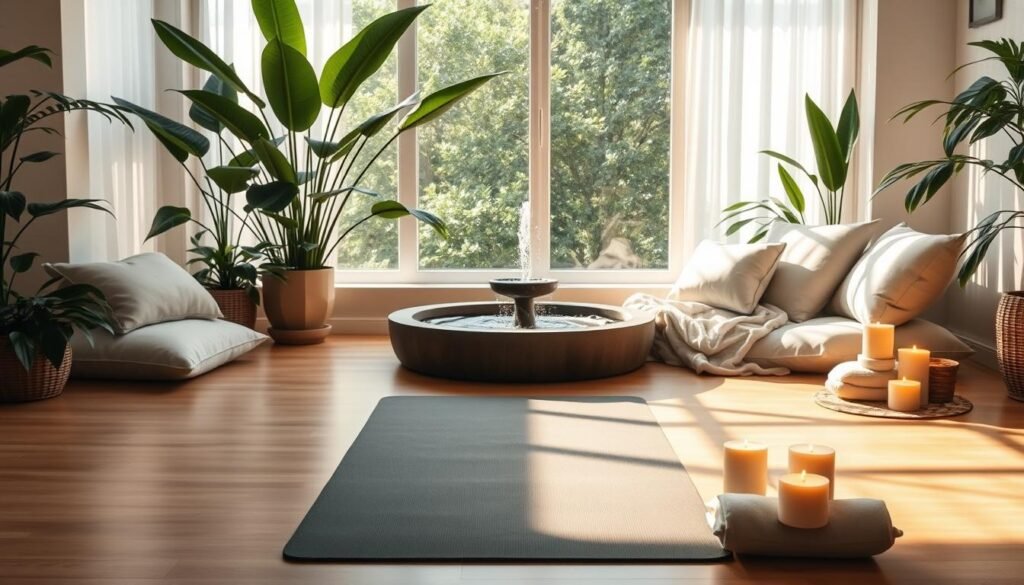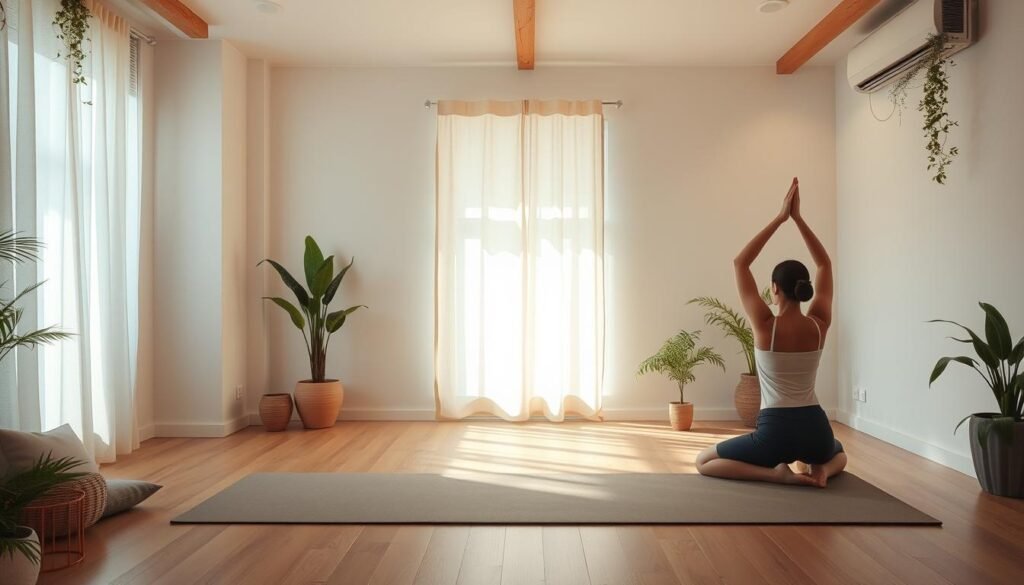Do you struggle with chronic pain and stress? You’re not alone. The National Institute of Health says pain affects more Americans than diabetes, heart disease, and cancer. Gentle exercises like yoga, tai chi, and light stretching can help. They improve flexibility, reduce muscle tension, and boost circulation.
Regular exercise boosts self-confidence and mood. It lowers symptoms of mild depression and anxiety. It may even trigger endorphins, the brain’s feel-good chemicals. Even short periods of activity are beneficial, and enjoying your exercise is key to stress relief.
Adding gentle exercises to your daily routine can improve your well-being. The Department of Health and Human Services suggests 150 minutes of moderate aerobic activity or 75 minutes of vigorous activity weekly. Gentle exercises and stress management techniques can help achieve this goal.
Key Takeaways
- Gentle exercises like yoga, tai chi, and light stretching can help ease chronic pain and stress.
- Regular exercise can increase self-confidence, improve mood, and lower symptoms of mild depression and anxiety.
- Even brief bouts of physical activity offer health benefits and can be part of effective stress management techniques.
- Finding an exercise that you enjoy is key to reducing stress and easing chronic pain and stress.
- Incorporating gentle exercises into your daily routine can lead to chronic pain relief and improved overall well-being.
- Exercise should be included in your schedule throughout the week for maximum stress-relief benefits and to ease chronic pain and stress.
Understanding the Mind-Body Connection in Pain Management
Exploring natural remedies for chronic pain means looking at holistic stress relief too. The mind-body connection is key in managing pain. Chronic stress can make pain worse, like in arthritis, fibromyalgia, and migraines.
Mindfulness meditation can lessen pain and improve outcomes. Deep, slow breathing also helps by lowering stress hormones. These practices can help you feel better by connecting your mind and body.
How Stress Affects Physical Pain
Stress can really hurt your body, making pain management tough. Stress hormones like cortisol can make inflammation and pain worse. Using stress relief techniques can help lower your pain and improve life quality.
The Science Behind Movement and Pain Relief
Exercise can help with anxiety and depression, which often go with chronic pain. It can also cut down inflammation and ease pain. Adding gentle movement to your day can help with chronic pain and boost your health.
Managing pain well means tackling both physical and emotional sides. By understanding the mind-body link and using stress relief, you’re on your way to a pain-free life.
The Power of Gentle Movement for Your Well-being
Gentle movements like yoga and tai chi are great for your health. They help reduce stress and ease chronic pain. Adding stress reduction tips to your day can boost your mental and physical health.
The National Institute of Health says these practices can lower anxiety and depression. They also help you sleep better and live a better life.
Some benefits of gentle movement include:
- Reducing chronic pain symptoms
- Improving muscle flexibility and range of motion
- Enhancing overall well-being
Using coping strategies for chronic pain and pain and stress relief methods can help you manage your health. Regular gentle movement can lower stress and improve your mood.
Even a little gentle movement can make a big difference. Just five minutes of stretching a day can help with pain and improve your well-being. Adding gentle movement to your daily routine can greatly benefit your life.
Getting Started with Mindful Exercise Practices
Starting mindful exercise practices can seem tough, but it’s doable. First, learn how lifestyle changes for managing pain and stress work. Adding stress management techniques to your day helps you deal with chronic pain better.
The Mayo Clinic says regular exercise can cut down anxiety and depression. It also improves sleep and boosts life quality. Mindful exercise is a top natural remedy for chronic pain. It combines physical activity with mindfulness to manage pain and stress well.
Essential Equipment and Props
You’ll need some basic gear to start with mindful exercise. This includes a yoga mat, blocks, straps, and a comfy cushion. You can also use stress management techniques like deep breathing, meditation, and muscle relaxation in your practice.
Creating a Comfortable Practice Schedule
Having a good practice schedule is key. Start with a few minutes each day and grow as you get more comfortable. Always listen to your body and only do what feels right and safe.

Setting Realistic Goals
Setting realistic goals is vital for success in mindful exercise. Begin with small goals, like practicing for 10 minutes a day. Then, increase the time and intensity as you get better. By making lifestyle changes for managing pain and stress part of your daily life, you can manage chronic pain and feel better overall.
| Benefits of Mindful Exercise Practices | Results |
|---|---|
| Reduces symptoms of anxiety and depression | Improved mental health |
| Improves sleep quality | Better overall health |
| Enhances overall quality of life | Increased sense of well-being |
Yoga Poses to Ease Chronic Pain and Stress
Yoga can help ease chronic pain and stress. It reduces pain symptoms, improves sleep, and boosts life quality. Gentle movements and deep breathing can help you feel better.
Chronic pain affects 50 to 75 million Americans. It comes from past pain, trauma, and stress. Yoga can help by calming the mind and body.
Beginner-Friendly Poses
Start with poses like child’s pose, cat-cow stretches, and seated forward bends. These are easy to do and can help with pain and stress. Poses like supported backbend and reclining bound angle activate the healing response.

Modified Poses for Limited Mobility
Even with limited mobility, you can do yoga. Try savasana and figure 4 poses while seated or lying down. Hold each pose for 1 to 5 minutes, focusing on breathing and relaxation.
Breathing Techniques for Enhanced Benefits
Deep breathing is key in yoga. It makes poses more effective for pain and stress relief. Add techniques like deep breathing or alternate nostril breathing to your practice for better results.
Exploring Tai Chi for Pain Management
Tai chi is a gentle, slow exercise that can ease chronic pain and stress. It promotes relaxation and balance. The Mayo Clinic says tai chi can lessen chronic pain, boost balance, and improve life quality.
Some benefits of tai chi for pain management include:
- Reducing stress and anxiety
- Improving sleep quality
- Increasing flexibility and balance
- Enhancing overall well-being
Tai chi is a mind-body connection for pain and stress method. It helps people find ways to cope with chronic pain. Regular tai chi practice can lead to better pain management and life quality. Its slow movements also build muscle strength without strain.

Tai chi is a great choice for those looking for a holistic pain management approach. Adding tai chi to your routine can help ease chronic pain and enhance your overall health.
Simple Stretching Routines for Daily Relief
Adding simple stretches to your daily routine can help a lot with chronic pain and stress. Making lifestyle changes can boost your well-being. Regular stretching can lessen chronic pain, boost flexibility, and enhance life quality.
Studies show stretching eases tension and stress, helping you relax when things get tough. Start with morning stretches like the Cat and Camel Stretch. Hold each stretch for 5 to 10 seconds and do it as many times as you need. For those who sit a lot, desktop stretches can help reduce stress and improve posture. Try the Shoulder Opener with a strap, doing it 5 times.

In the evening, try relaxation stretches like the Half Downward-Facing Dog pose. Hold it for 10 deep breaths. You can also do Scapular Push-ups, repeating them 10 times. Always warm up with 5 to 10 minutes of light activity before stretching. Hold each stretch for about 30 seconds. By adding these simple stretches to your day, you can feel better and live healthier.
| Stretching Exercise | Duration |
|---|---|
| Cat and Camel Stretch | 5-10 seconds |
| Shoulder Opener with a strap | 5 repetitions |
| Half Downward-Facing Dog pose | 10 deep breaths |
| Scapular Push-ups | 10 repetitions |
Creating Your Ideal Exercise Environment
To get the most out of gentle movement, you need a special place. This area should be calm, helping you feel less stressed and anxious. Adding natural remedies like soothing colors and comfy temperatures makes it perfect for relaxation.
Think about how your exercise space affects your body and mind. Lighting and temperature are key. Soft, warm lights and a cozy temperature set a peaceful mood. Music and sounds can also help, making you more focused and calm.
Key Elements for a Peaceful Exercise Environment
- Comfortable temperature range (around 68-72°F)
- Soothing lighting (soft, warm, and calming)
- Calm music or nature sounds
- Pleasant aromas (e.g., lavender or vanilla)
The Mayo Clinic says a calm space can help with anxiety and depression. It can also improve sleep and life quality. Adding these elements makes your exercise area great for your body and mind, helping with chronic pain and stress.

Using Aromatherapy to Enhance Practice
Aromatherapy is a great way to make your exercise space more peaceful. Scents like lavender and vanilla help you relax and feel less stressed. Using aromatherapy in your routine can make your gentle movements more effective, helping you feel calm and manage pain better.
| Aromatherapy Scents | Benefits |
|---|---|
| Lavender | Promotes relaxation and reduces anxiety |
| Vanilla | Calms the mind and promotes a sense of well-being |
Incorporating Mindfulness into Your Movement Practice
As you keep working on managing chronic pain and stress, adding mindfulness to your exercise routine is key. Mindfulness makes you more aware of your thoughts, feelings, and body sensations. This helps you deal with pain and stress better. Mixing mindfulness with exercise boosts the exercise’s benefits and improves your health.
Mindfulness has many benefits. It can lower anxiety and depression, help you sleep better, and make life feel more fulfilling. Meditation and deep breathing can cut down stress hormones, relax you, and make pain feel less intense. Mindfulness also means less stress, lower blood pressure, and a stronger immune system.
Here are some ways to add mindfulness to your exercise:
- Focus on your breath and the sensations in your body as you move
- Pay attention to your thoughts and emotions, without judgment
- Practice self-compassion and kindness towards yourself
Adding mindfulness to your exercise can lead to less pain, better mood, and more self-compassion. Start slow and be kind to yourself as you build your mindfulness practice. With regular effort, you’ll see the benefits of exercise grow and your life quality improve.
| Benefits of Mindfulness | Results |
|---|---|
| Reduced symptoms of anxiety and depression | Improved mental health |
| Improved sleep | Better overall well-being |
| Enhanced overall quality of life | Increased feelings of self-compassion and well-being |
Safety Guidelines and Precautions
Starting a new exercise routine means thinking about safety first. This is key when you have chronic pain and stress. The right lifestyle changes for managing pain and stress can help a lot.
Before you start, talk to a healthcare provider. They can help you make a safe and effective plan. Discussing stress management techniques and natural remedies for chronic pain is also important.
Here are some safety tips to keep in mind:
- Listen to your body and stop if you feel pain or discomfort.
- Adjust exercises to fit your fitness level and abilities.
- Warm up and cool down to prevent injuries.
- Stay hydrated and eat a balanced diet.
By following these tips and making lifestyle changes for managing pain and stress, you can avoid injuries. Always put your safety and well-being first. If you have concerns, talk to a healthcare provider.
| Safety Guidelines | Precautions |
|---|---|
| Listen to your body | Stop exercise if you experience pain or discomfort |
| Modify exercises | Suit your fitness level and abilities |
| Warm up and cool down | Prevent injury and reduce muscle soreness |
Conclusion: Your Journey to Pain-Free Living Through Mindful Movement
Your path to pain-free living is within reach. By adding gentle exercises like yoga, tai chi, and simple stretching routines, you can tap into the mind-body connection. This helps ease chronic pain and stress. Remember, this is a personal journey. Be patient, persistent, and kind to yourself.
The National Institute of Health says regular exercise and mindful movement can reduce symptoms of chronic pain. It also improves sleep and boosts your quality of life. Take this chance to improve your well-being and start a journey towards chronic pain relief and stress management.
As you keep adding mindful movement to your daily life, enjoy the moments of calm. Feel the increased body awareness and the sense of inner peace these practices bring. Your dedication to this path will lead you to a more fulfilling, pain-free life.



